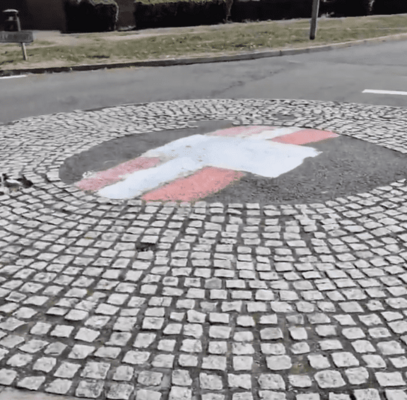AT a time of great global uncertainty, fear and confusion little rays of sunshine are all the more warming and welcome. Last week on TV there appeared a lovely little story from County Antrim – a story in which Squinter has had a modest and fleeting hand.
Wildlife lover Ciarán Walsh moved some years ago to the countryside near Crumlin where he has been able to devote incredible amounts of time and energy to pursuing his passion for saving the barn owl. The number of mating pairs of the magnificent native Irish bird has dropped alarmingly over the years thanks mainly to changes in farming practices which have decimated both their habitat and their food source. And so Ciarán, possessed of all the necessary official permissions and licences required to interact with the barn owl, has been erecting nest boxes in areas where the bird formerly thrived, and he has been laying out seed to swell the numbers of the various rodents which are the mainstay of the barn owl diet.
In 2018 Squinter assisted Ciarán in the ringing of six owlets at a nest in an old farm outbuilding – a brood size rarely if ever seen. It was the thrill of a lifetime and the personal excitement of getting up close and personal with one of Ireland’s most beautiful and iconic birds was mixed with a feeling of huge satisfaction that Squinter had helped in whatever tiny way in the battle to save to the barn owl.
So when news broke last week that four more chicks had been ringed at another County Antrim nest – an event attended and reported on by our wildlife correspondent Dúlra in a wonderful article which you can read now on the Belfast Media Group website – thoughts of war and global warming and recession were temporarily swept away and Squinter found himself smiling broadly at the TV report which brought us the glad news and which was tweeted out by RTÉ.
The report was also watched by former First Minister, Jot and Tittle Dodger, Crocodile Wrangler and Protocol Broker Arlene Foster. Now Arlene, as we know, is a great promoter of Our Wee Country. In fact, many, if not most, of her tweets are accompanied by the hashtag #ProudofNI. So one might have expected that this latest boost to the barn owl population of loyal Ulster would have been greeted with delight. Far from it. Arlene’s first thought on watching a television report detailing a huge success in the fight to save the barn owl was to complain that the words ‘Northern Ireland’ weren’t used in the RTÉ tweet and report. She tweeted in response: “I see after 101 years RTE News still can’t call us by our properly constituted name #NorthernIreland #ProudofNI”
I see after 101 years @rtenews still can’t call us by our properly constituted name #NorthernIreland #ProudofNI https://t.co/gVLTIHAQao
— Arlene Foster DBE PC #ProudofNI. (@ArleneFosterUK) July 19, 2022
If the Brexit debacle has taught us anything over the past six years it’s that Arlene and her DUP colleagues struggle when it comes to the concept of borders. The extent of the enthusiasm with which they answered the call of the Tory hard right was sadly not matched by the depth of their appreciation of the likely consequences for the Precious Union®. They were warned at every turn not to put their hand in the Brexit fire and now the DUP is running around waving about a heavily-bandaged forearm and pleading for somebody to help with the pain.
But if the understanding of border intricacies is clearly limited among Arlene and her former compadres, it’s non-existent among barn owls on the island of Ireland. A fluffy owlet in the chimney of an abandoned farmstead in County Cork is no more a Republic of Ireland barn owl than one in a County Antrim hayloft is a Northern Ireland barn owl. They are simply barn owls and they exist as part of an island ecosystem which recognises neither land division nor political jurisdiction. Indeed, one of the six owlets that Squinter saw being ringed in 2018 died in a collision with a power cable in Drogheda, and it didn’t move South because of higher wages and a superior road structure, just as any siblings which may have stayed in County Antrim will not have done so because of an attachment to the NHS or the royal family.
There are many things about the barn owl that give serious cause for concern and which Arlene might more constructively have tweeted about: the precipitous fall in numbers in recent years; the fact that they are officially a ‘species of concern’; the continuing threat to barn owl habitat and food sources. There are even reasons to be cheerful which Arlene might have celebrated on social media: the passion with which Ciarán and his colleagues go about their business; the encouraging correlation between healthy and plentiful food sources and larger broods. But no. Arlene got cross because in a tweet and a two-minute news report nobody called the barn owl the Northern Ireland barn owl; or the barn owl from Northern Ireland; or the Northern Irish barn owl.
Of course unionists, and the DUP in particular, are pernickety about the “properly constituted” name of this little corner of Heaven when it suits them. But they move smoothly between “Northern Ireland”, “Ulster” and “the Province”, none of which is properly constituted and both of which are geographically and historically nonsensical.
Might Arlene have been placated if RTÉ had referred to an “Ulster barn owl”? Would things have turned out better had the reporter described the brood as “owlets from the Province”? Perhaps, but viewers in Donegal, Monaghan and Cavan might have struggled to get their heads round either of those.
“Mainland” – there’s another nonsensical term that unionists are fond of using. The problem with that one is that neither “Northern Ireland”, “the Province” or “Ulster” is an island and only an island can have a mainland. Squinter suspects that Arlene might be quite chuffed if any of the new brood crossed over into the Mainland in a display of Precious Union® solidarity. But if they do they won’t be checking into the Irish Sea border put in place by the DUP – led by one Arlene Foster MLA.
Now there’s a tweet.
Why there are no tickets to Newry Central?
SHANKS’S MARE: The long road to Newry
SQUINTER’S been in Newry train station many times, but only passing through on the way to Dublin. He’s been in Newry many times, but he never saw the train station as he walked around the town. Last weekend he found out why.
Squinter jumped on the train at Lanyon Place on Saturday morning and headed to Newry for lunch and a dander. Squinter loves trains. No idea why, he just looks forward to travelling on trains in a way that he never did with planes or buses or taxis.
40 minutes later and he’s the first passenger out of the station, attempting to get his bearings in the car park – not that difficult, as it turns out, because there’s only one way to go and that’s over a bridge crossing the motorway south. Or north. So Squinter starts walking. There’s a single Ulsterbus idling noisily in a lay-by to his right, but apart from that, the place is surprisingly quiet.
Squinter puts in the earphones and sets off.
Five minutes later and Squinter’s beginning to wonder what the hell’s going on because there’s no sign of even the beginning of urban build-up and the road seems very residential to be the main drag into a big town, but on he cracks. It’s a bit of a relief when he hits a main road after ten minutes, but it’s a main road which quite literally has nothing on it. Not a business, not a house, not a shop, not a pavement, just a mass of yellow gorse bushes adorning wire-clad walls. On Squinter goes, along a hard shoulder now, and this is turning into what used to be called in Squinter’s youth a four-day camel ride. After another ten minutes of bleak and featureless road Squinter is convinced that he’s somewhere near Lurgan by now, but when he spots the familiar red star of a Texaco filling station in the distance, hope is rekindled. As the petrol station draws closer, Squinter sees that it’s on a roundabout, which at least offers the prospect of people and activity and – most importantly – signs. And as he drops on to the roundabout there indeed is a sign for Newry, but the road is only an extension of the grim tarmac hell-road he thought he’d left behind.
On and on and at least now businesses are starting to appear: a hardware store, a large veterinary compound, Norbrook laboratories. Then comes another roundabout, a smaller one this time and on it is another sign for Newry, except this one contains the blessed words ‘city centre’. The roundabout looks vaguely familiar and as Squinter proceeds along the road to Newry he recognises it as as the road to Dublin before the motorway bypass was built.
Another 15 minutes and Sacred Heart Grammar School hoves into view, then Newry High School; a cop station, a Tesco, but no city centre. Squinter’s almost whimpering by the time he hits the canal and the familiar Georgian architecture on and around the Mall. It’s not a café for lunch that Squinter falls into, but a bar for a restorative pint and a spell of contemplation. And what he contemplates is that while Squinter enjoys nothing more than a long walk – two hours is par for the course – an expected short walk that turns into a long walk takes a heavy toll on the human psyche.
Later that evening in the Roddy’s and Squinter is informed by more knowledgeable pals that – oh, yes – Newry train station is indeed a four-day camel ride from Newry and that the bus he had sailed by in the lay-by had been the Translink city centre shuttle.
A series of disastrous wrong turns and double-backs had turned a half-hour dander into a 75-minute one and taken Squinter on a very unscenic tour of Newry’s outer environs. But he consoled himself with the fact that it wasn’t entirely his fault.
Because how come nobody told Squinter at the station there’s a shuttle bus? And how come nobody told him that Newry’s train station needs a train line into Newry?






